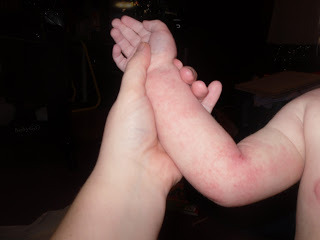Handling Food Allergies In the Classroom
Today I have with me a friend and editing colleague visiting here today to help answer questions every parent of a kid with food allergies considers before making the decision to send their child to school. Bea runs the popular book review site Bea's Book Nook, and is also a teacher with more than twenty years' of experience in the classroom. She's been a great help to me as I've started homeschooling Stinkerbell's preschool, and her post today is absolutely the most helpful I've come across when dealing with food allergies in classrooms or child care environments!
Thank you Bea!
Handling Food Allergies in the Classroom
Thank you Calle for letting me come on your blog and share my experience with you and your readers.
I’m Bea.
I have food allergies, I run a book review blog, I edit, and I teach. The school I teach at is an early childhood center that has children ranging in age from two months to nine years of age, but most of what I have to say is applicable in all classrooms, regardless of the child’s age. Let me state that I am not a medical professional. I have basic first aid and CPR training but that’s the extent of my medical training. Always discuss matters with your doctor.
 When I first started teaching twenty-one years ago, we didn’t have any students with food allergies. These days, every classroom in my school has at least one student with a food allergy. Over the years we have developed procedures and the state also has regulations on how to handle food allergies.
When I first started teaching twenty-one years ago, we didn’t have any students with food allergies. These days, every classroom in my school has at least one student with a food allergy. Over the years we have developed procedures and the state also has regulations on how to handle food allergies.The most important tool for keeping your child safe is communication. From the time you enroll your child or they are diagnosed, you need to constantly communicate with the school and with your child’s teachers. Most school forms have a place for noting medical issues; make sure that you are detailed and honest. Depending on the severity of the allergies, or how plentiful they are, arrange a meeting with the teachers and, if there is one, a school nurse.
This is your time to discuss any concerns and worries you have. Inquire as to the policy for food being served in the room or just being present in the room. How and where is food stored? Do you need to provide your own food? What are the school’s policies on what food can be served? Ask what the policies and procedures are for your school and your child’s classroom in particular. What about special events in the classroom?
Will the teacher notify you in advance so you can provide something for the occasion? Is it possible for you to keep something on hand for those occasions? Is there a cafeteria or central eating room? What arrangements need to happen to allow your child to safely eat there? Maybe a separate table? Dishes from home? How severe are your child’s allergies? Do they need to actually ingest the food? Touch it? Breathe it in? The teachers and administration need to know this so they can plan accordingly.
Say your child has a peanut allergy. Do they have to actually eat a peanut or peanut product or will they react if they touch it? What about the residue from the oil, will that cause a reaction?
The state I teach in has such strict regs around serving food to children with allergies that we now require all children with allergies to bring their own snacks in addition to lunches (we typically provide snacks and parents provide lunches). We are not allowed to serve them any school food; additionally all packaged food, crackers, etc., must remain in the package for storage. Prior to this regulation change, we had parents look over our snacks and approve which ones could be served. We can no longer do that. If it helps, make a list of questions and concerns and as you all talk, add to your list.
Ask to see the kitchen and cafeteria if the school has those; a visit may prompt more questions on your part. Be sure to detail the exact reaction that your child has. Bear in mind that younger children don’t view the world or express themselves the way we do. A throat that is closing up may be described by the child as a fuzzy throat, for instance. So please share as much information as you have with the teachers; it could save valuable time in the event of a reaction.
 This year, I have a child with a peanut allergy. To the best of his parents knowledge, he has to actually ingest the peanut product but we, the teaching team, are paranoid. So, we have two tray chairs (it’s a class of one and two year olds) that we have reserved as peanut-free. Each chair and tray has a large laminated “No Peanuts” sign prominently attached. So, our child who is peanut allergic, I’ll call him Henry, sits there for every snack and lunch and the other chair is available for any child with peanut-free food. We’ve also designated certain chairs and tables specifically for peanuts. Some parents use alternative butters such as soy butter or almond butter in their children’s lunches. If the parent doesn’t tell us about it at drop-off, when we open up the lunch boxes, we assume it’s peanut butter and behave accordingly.
This year, I have a child with a peanut allergy. To the best of his parents knowledge, he has to actually ingest the peanut product but we, the teaching team, are paranoid. So, we have two tray chairs (it’s a class of one and two year olds) that we have reserved as peanut-free. Each chair and tray has a large laminated “No Peanuts” sign prominently attached. So, our child who is peanut allergic, I’ll call him Henry, sits there for every snack and lunch and the other chair is available for any child with peanut-free food. We’ve also designated certain chairs and tables specifically for peanuts. Some parents use alternative butters such as soy butter or almond butter in their children’s lunches. If the parent doesn’t tell us about it at drop-off, when we open up the lunch boxes, we assume it’s peanut butter and behave accordingly. No child may leave their chair until they have been thoroughly washed and we make sure when Henry is done eating, that he stays out of the kitchen area until it is fully cleaned up.
Additionally, every classroom posts their children with allergies. A close up facial shot with a paper stating what they are allergic to and what to do if the child has a reaction is prominently displayed on an upper cabinet door in the kitchen area. So, if a substitute teacher is in the room, the info on who can’t have what is right there in front of them. If your school doesn’t do this, ask how teachers, aides, subs, etc., know who has allergies and what they’re allergic to.
Each family also provides written directions on what to do in case of a reaction or suspected exposure and the necessary medicine. So Henry has a bag in the classroom easily accessible to teachers with the same info that’s posted in the kitchen plus directions on what to do, which parent to call and at what number, a bottle of children’s Benadryl and an epi-pen.
All staff at our school are trained each year to administer an epi-pen, an injector that allows us to inject epinephrine to slow down a reaction. In addition to providing all this for the classroom, the parents are asked to provide a second bag to be kept in the office. That way, wherever the child is when he or she reacts, a teacher can go wherever is closest, to the office or classroom, so that no time is wasted.
 Allergic reactions can take many different
Allergic reactions can take many differentforms. Stinkerbell's are most often
skin-related, on her arms,
legs, tush, belly, and face.The state currently doesn’t allow us to do that, so any cooking can only happen when the child with allergies is not in attendance that day. If your school cooks, be sure to discuss what the procedures are and be willing to work with the teachers so they can make foods that are safe for your child. I always had parents double-check the ingredients that I was going to use and look over the recipe to see if they spotted any potential problems. Perhaps you can provide recipes that you know are safe for your child and identify safe foods that can be used in recipes.
It is possible for your child with allergies to safely attend school. You and the school need to communicate and work together to make it happen. Don’t hesitate to ask questions or to ask for a plan to be put in writing. If it helps when dealing with administration, think of your child’s allergies as a special need and schools are required to make reasonable accommodations.
I hope this has helped and if you have further questions, you are welcome to email me at beasbooknook@gmail.com. I’m happy to answer and to talk with you.
Also, anyone commenting on any posts made between 5/15 and 5/19 will be entered to win the prizes I'm giving away for the Rachel Van Dyken Blog Hop Party going on now!
Published on May 17, 2013 00:30
No comments have been added yet.
Read More from Calle J. Brookes
Here you'll find information about the latest releases, deleted scenes, bonus short stories--and stories that are only available on the blog!
Here you'll find information about the latest releases, deleted scenes, bonus short stories--and stories that are only available on the blog!
...more
- Calle J. Brookes's profile
- 381 followers



